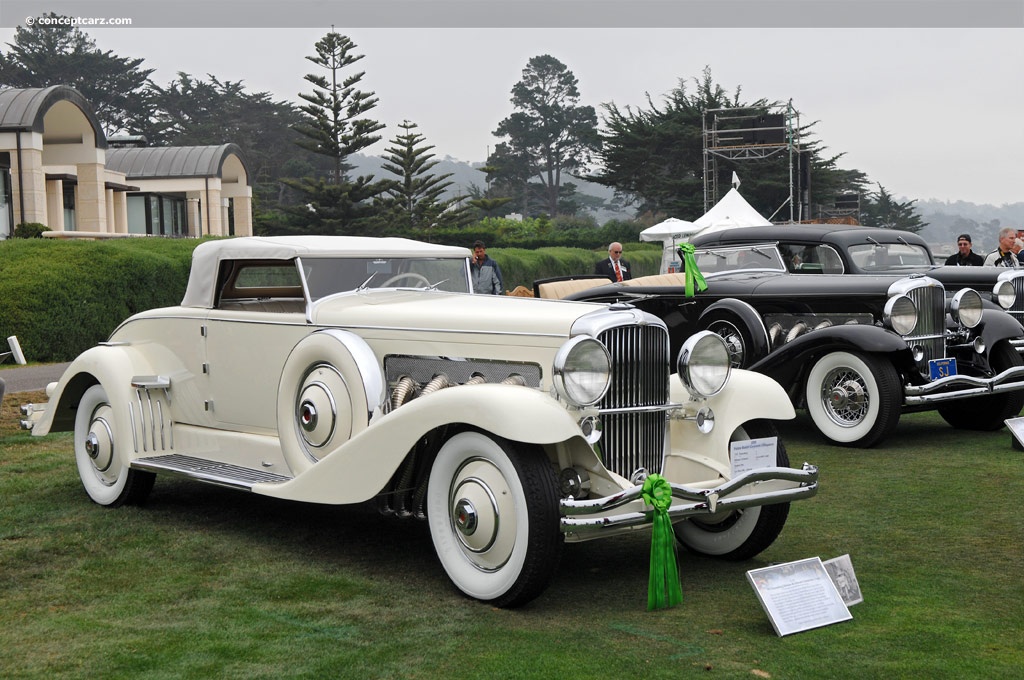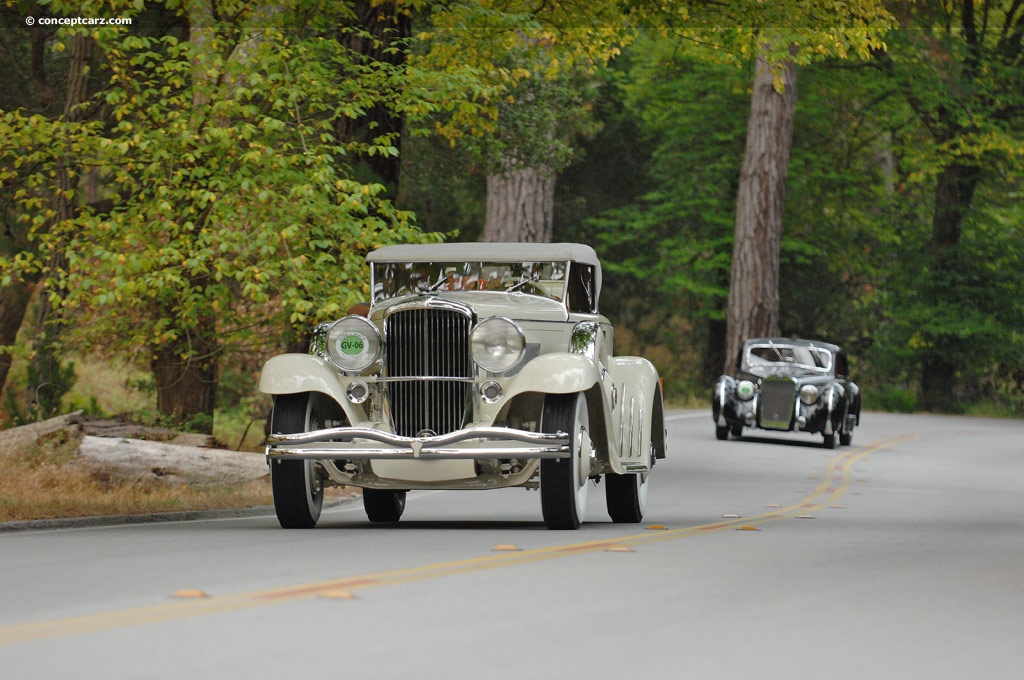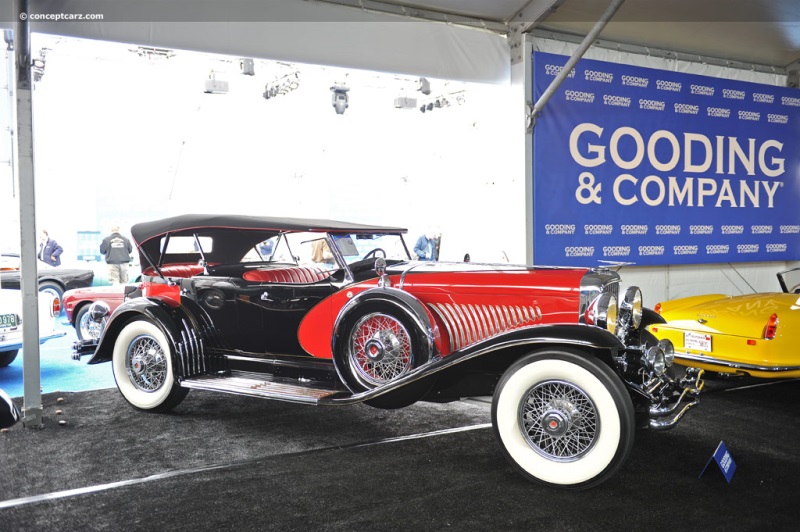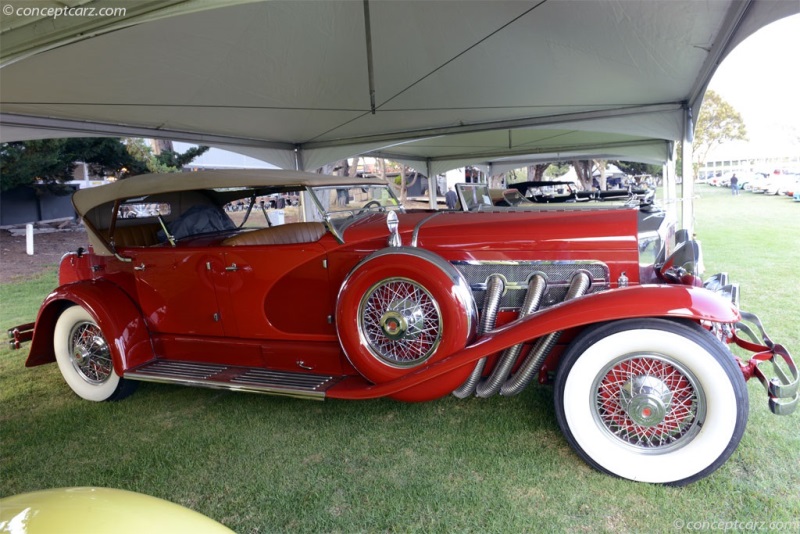The Duesenberg company was founded by brothers Frederick and August Duesenberg in 1913 with the purpose of building winning, hand-built race cars. the company was acquired by E.L. Cord, owner of Auburn Automobile, in 1926. Cord challenged Fred Duesenberg to create the fastest, biggest, and most luxurious car in the world - resulting in the Duesenberg Model j. The J was powered by a 420 cubic-inch, DOHC straight-eight engine based on the Duesenberg brothers' successful racing engines of the 1920s. The design was by Fred but they were produced by another of Cord's companies, Lycoming. Sans supercharger, the engine produced 265 horsepower with a top speed of over 100 mph.
The Duesenberg Model J was introduced on December 1st, 1928 at the New York Auto Salon. Duesenberg ordered enough components to build 500 Model Js while development continued for six months after the Model J's introduction to ensure the highest possible build quality. Approximately five months before the stock market crash on Black Tuesday, the first customer delivery occurred in May of 1929.
At the time of its introduction, only one other car was in a similar price category, the steam-powered Doble. Auburn's were priced between $995 to 2,095, and Cord's own L-29 peaked at around $3,300. The Model J trumped those figures, falling between $13,000 and $19,000, although two American-bodied J's reached $25,000. The cost of the chassis was $8,500, and after 1932 it rose to $9,500.
Among the most powerful engines of this era included those from Pierce-Arrow and Auburn, both delivering approximately 125 horsepower. Most of the engines used an L-head design with two valves per cylinder and provided top speeds of around 50 to 60 mph. The Chrysler Imperial 80 delivered 112 horsepower. Cadillac's sixteen-cylinder engine with 7.4 liters delivered 165 horsepower. Marmon's sixteen-cylinder engine, with an 8.0-liter displacement, produced 200 horsepower at 3,400 RPM. The Model J used twin overhead cams and four valves per cylinder, delivering 265 horsepower. Put simply, the Model J was the most technically advanced car in America and the most powerful on the road. The second gear's top speed of 90 MPH amazed and astonished the most skeptical customers. With the installation of a centrifugal supercharger, available beginning in 1932, horsepower rose to 320 HP.
Coachbuilders
The list of coachbuilders includes Derham, Holdbrook, Judkins, Gurney Nutting, Saoutchik, Franay, Fernandez et Darrin, Willoughby, Weyman, Walker, Rollston, Murphy, and Le Baron.
Coupe
Chassis #: 2162
Engine #: J-137
View info and historyDerham
The first bodies ordered by Duesenberg for the new Model J were designed and built by Derham Body Co. of Rosemont, Pennsylvania. It was a family business founded in 1887 and purposely organized for flexibility in meeting varying demands from private and corporate customers alike. Phil Derham, the family scion, was later appointed by E.L. Cord to head of Duesenberg's Custom Coachwork Divison. Derham Body Co. would eventually design and build more than 40 custom bodies for the Model J and SJ.
LeBaron
LeBaron was among the first coachbuilders to develop bodies for the new Model J. Their 'sweep panel' dual-cowl phaeton was built for three years before Duesenberg made the decision to build this design in-house. Duesenberg's designer, Gordon M. Buehrig, progressed the design further, making slight alterations by raising the body's beltline, incorporating a reverse-curved cowl, and adding a more subtly curved 'sweep panel.' The top was reworked so that it would fold nearly flush with the rear of the coachwork when lowered. Built on both the short- and long-wheelbase, they were constructed by Union City Body Company, a Cord Corporation holding, under the fanciful nameplate of LaGrande. Chosen to represent bodies built for Duesenberg by Cord entities, the LaGrande bodies were built by company branches in Denver, Florida, Philadelphia, Los Angeles, Chicago, and New York City.Gordon Buehrig
Approximately half of the Model Js wore coachwork devised by Buehrig. His design department at Duesenberg created designs that were sold under other coachbuilders' names, including the famed Tourster four-door phaetons built by Derham. The first Derham Tourster was displayed at the 1931 Chicago Auto Salon held in 1930 to herald the new year's models. It wore yellow paint with pastel green fenders, and after its debut, it was sent to the Los Angeles Salon. A total of eight Derham Toursters were built with many being owned by famous and prominent owners.Walter M. Murphy, Inc.
The Murphy body company of Pasadena, California, created simple and elegant designs, with its trademark body design being the clear vision pillar. On the convertible coupe, the windshield pillars were designed to be as slim as possible, enhancing the open appearance and improving visibility for the driver. Murphy advertised their windshield pillars as 'narrower than the space between a man's eyes.'
Convertible Coupe by Bohman & Schwartz
View info and historyApproximately 100 bodies were built by Murphy for Duesenberg, with approximately sixty being the two-passenger convertible coupe with a rumble seat. Murphy initially produced the convertible coupe with a top that folded down into a low pile and was exposed behind the driver's seat (about 25 of these were built), followed by a series of interim cars, with each example having unique styling features. These 'interim' cars had a top that folded down into a well behind the seat and was covered by a low leather snap-on tonneau. This styling feature was followed by a true 'disappearing top' model, in which a flush-fitting metal lid replaced the tonneau, giving it the sporting appearance of a true roadster.Production
Most of the engines and chassis were made in 1929 and 1930 and were sold and bodied throughout subsequent years. The company's goal to sell 500 cars a year was never achieved. They built around 200 examples by the time the Great Depression hit in October of 1929, with an additional 100 orders filled in 1930. 481 Model Js of all versions were built between 1928 and 1937, with about 378 remaining in existence. Ten examples of the JN were produced in 1935, all wearing Rollston coachwork. Two were SSJ short-wheelbase supercharged J models resting on a 125-inch wheelbase. The engine, with the help of a dual carburetor 'ram's horn' manifold, delivered nearly 400 horsepower. Thirty-six examples were SJs. One example was known as the Mormon Meteor, commissioned and used by Ab Jenkins as a speed record car. Jenkins drove the car in October of 1935 to a one-hour record of 153.97 mph and a twenty-four-hour record of 135.57 mph at a circuit on the Bonneville Salt Flats.
The price, performance, and exclusivity of the Model J validated E.L. Cord's goal of building the best automobile in the world. These multi-passenger family automobiles, complete with luggage, were faster than any other automobile on the road. The style and elegance matched the performance and were a milestone in classic coachwork.Mechanical Specification
The Duesenberg Model J had a standard wheelbase size of 142.5 inches or an optional long wheelbase size of 153.5 inches. The 'SSJ,' of which only two were built, used a short 125-inch wheelbase. A few examples had a 160-inch wheelbase.
Convertible Coupe by Bohman & Schwartz
View info and historyThe 420 cubic-inch straight-eight engine had a cast iron block, a cast iron cylinder head, 5.7:1 compression, four valves per cylinder, and dual overhead camshafts. It had a 3.74-inch cylinder bore and a 4.76-inch piston stroke. Manufactured by Lycoming, it produced 265 horsepower in naturally aspirated form, or 320 horsepower with a supercharger. Braking was done by hydraulic drums, and the suspension was via semi-elliptic leaf springs. During its production lifespan, lasting from 1928 to 1937, few changes were implemented. The first major change was the replacement four-speed gearbox that had been unable to handle the engine's power. Its replacement was an unsynchronised three-speed gearbox, subsequently fitted to all Duesenbergs.
by Daniel Vaughan | May 2020
The Duesenberg Model J was introduced on December 1st, 1928 at the New York Auto Salon. Duesenberg ordered enough components to build 500 Model Js while development continued for six months after the Model J's introduction to ensure the highest possible build quality. Approximately five months before the stock market crash on Black Tuesday, the first customer delivery occurred in May of 1929.
At the time of its introduction, only one other car was in a similar price category, the steam-powered Doble. Auburn's were priced between $995 to 2,095, and Cord's own L-29 peaked at around $3,300. The Model J trumped those figures, falling between $13,000 and $19,000, although two American-bodied J's reached $25,000. The cost of the chassis was $8,500, and after 1932 it rose to $9,500.
Among the most powerful engines of this era included those from Pierce-Arrow and Auburn, both delivering approximately 125 horsepower. Most of the engines used an L-head design with two valves per cylinder and provided top speeds of around 50 to 60 mph. The Chrysler Imperial 80 delivered 112 horsepower. Cadillac's sixteen-cylinder engine with 7.4 liters delivered 165 horsepower. Marmon's sixteen-cylinder engine, with an 8.0-liter displacement, produced 200 horsepower at 3,400 RPM. The Model J used twin overhead cams and four valves per cylinder, delivering 265 horsepower. Put simply, the Model J was the most technically advanced car in America and the most powerful on the road. The second gear's top speed of 90 MPH amazed and astonished the most skeptical customers. With the installation of a centrifugal supercharger, available beginning in 1932, horsepower rose to 320 HP.
Coachbuilders
The list of coachbuilders includes Derham, Holdbrook, Judkins, Gurney Nutting, Saoutchik, Franay, Fernandez et Darrin, Willoughby, Weyman, Walker, Rollston, Murphy, and Le Baron.

Coupe
Chassis #: 2162
Engine #: J-137
View info and history
The first bodies ordered by Duesenberg for the new Model J were designed and built by Derham Body Co. of Rosemont, Pennsylvania. It was a family business founded in 1887 and purposely organized for flexibility in meeting varying demands from private and corporate customers alike. Phil Derham, the family scion, was later appointed by E.L. Cord to head of Duesenberg's Custom Coachwork Divison. Derham Body Co. would eventually design and build more than 40 custom bodies for the Model J and SJ.
LeBaron
LeBaron was among the first coachbuilders to develop bodies for the new Model J. Their 'sweep panel' dual-cowl phaeton was built for three years before Duesenberg made the decision to build this design in-house. Duesenberg's designer, Gordon M. Buehrig, progressed the design further, making slight alterations by raising the body's beltline, incorporating a reverse-curved cowl, and adding a more subtly curved 'sweep panel.' The top was reworked so that it would fold nearly flush with the rear of the coachwork when lowered. Built on both the short- and long-wheelbase, they were constructed by Union City Body Company, a Cord Corporation holding, under the fanciful nameplate of LaGrande. Chosen to represent bodies built for Duesenberg by Cord entities, the LaGrande bodies were built by company branches in Denver, Florida, Philadelphia, Los Angeles, Chicago, and New York City.Gordon Buehrig
Approximately half of the Model Js wore coachwork devised by Buehrig. His design department at Duesenberg created designs that were sold under other coachbuilders' names, including the famed Tourster four-door phaetons built by Derham. The first Derham Tourster was displayed at the 1931 Chicago Auto Salon held in 1930 to herald the new year's models. It wore yellow paint with pastel green fenders, and after its debut, it was sent to the Los Angeles Salon. A total of eight Derham Toursters were built with many being owned by famous and prominent owners.Walter M. Murphy, Inc.
The Murphy body company of Pasadena, California, created simple and elegant designs, with its trademark body design being the clear vision pillar. On the convertible coupe, the windshield pillars were designed to be as slim as possible, enhancing the open appearance and improving visibility for the driver. Murphy advertised their windshield pillars as 'narrower than the space between a man's eyes.'

Convertible Coupe by Bohman & Schwartz
View info and history
Most of the engines and chassis were made in 1929 and 1930 and were sold and bodied throughout subsequent years. The company's goal to sell 500 cars a year was never achieved. They built around 200 examples by the time the Great Depression hit in October of 1929, with an additional 100 orders filled in 1930. 481 Model Js of all versions were built between 1928 and 1937, with about 378 remaining in existence. Ten examples of the JN were produced in 1935, all wearing Rollston coachwork. Two were SSJ short-wheelbase supercharged J models resting on a 125-inch wheelbase. The engine, with the help of a dual carburetor 'ram's horn' manifold, delivered nearly 400 horsepower. Thirty-six examples were SJs. One example was known as the Mormon Meteor, commissioned and used by Ab Jenkins as a speed record car. Jenkins drove the car in October of 1935 to a one-hour record of 153.97 mph and a twenty-four-hour record of 135.57 mph at a circuit on the Bonneville Salt Flats.
The price, performance, and exclusivity of the Model J validated E.L. Cord's goal of building the best automobile in the world. These multi-passenger family automobiles, complete with luggage, were faster than any other automobile on the road. The style and elegance matched the performance and were a milestone in classic coachwork.Mechanical Specification
The Duesenberg Model J had a standard wheelbase size of 142.5 inches or an optional long wheelbase size of 153.5 inches. The 'SSJ,' of which only two were built, used a short 125-inch wheelbase. A few examples had a 160-inch wheelbase.

Convertible Coupe by Bohman & Schwartz
View info and history
by Daniel Vaughan | May 2020
Background
The Duesenberg Company produced high-end, luxury automobiles and racing cars from 1913 through 1937. It was created by the Duesenberg brothers, Fred and August, who formed the Duesenberg Automobile %26 Motors Company, Inc. in Des Moines, Iowa with the intent on building sports cars. Just like many of their time, they were mostly self-taught engineers and had only constructed experimental cars up to....
Continue Reading >>
Continue Reading >>
Related Reading : Duesenberg Model J History
The Duesenberg Automobile %26 Motors Company, Inc was founded and operated by Fred and August, brothers who began their company in 1913. From the start, the company has been a US-based luxury automobile company with a standard to build the very best hand-built vehicles during the time period. Duesenberg vehicles lived up to this standard until 1937 when the company closed. Created to build sports....
Continue Reading >>
Continue Reading >>
1932 Duesenberg Model J Vehicle Profiles
Recent Vehicle Additions
Performance and Specification Comparison
Model J Specification Comparison by Year
Year
Production
Wheelbase
Engine
Prices
125.00 in., 142.50 in.
8 cyl., 420.00 CID., 265.00hp
8 cyl., 420.00 CID., 320.00hp
8 cyl., 420.00 CID., 320.00hp
$8,500 - $8,500
Related Automotive News

2014 Concours of America a Success
36th annual Concours dElegance of America at St. Johns a Resounding Success!
1932 Duesenberg Model J Convertible Victoria by Murphy and 1939 Bugatti T57C Cabriolet by Voll %26 Ruhrbeck win Best of Show at 2014 Concours dElegance of America a...

1932 Duesenberg J Figoni Sports Torpedo Named Best of Show at the 71st Pebble Beach Concours d'Elegance
2022 Charitable Donations Surpass %242.67 Million
A unique Duesenberg reprised its early role as Concours winner by taking the top prize at the Pebble Beach Concours dElegance.
This year, 40 classic cars from 18 countries and 33 states pulled...

Past Best of Show Winners at The Pebble Beach Concours d'Elegance
overview1
The 70th anniversary of the Pebble Beach Concours dElegance was celebrated with a spectacular display of previous Best of Show winners. Thirty-seven examples graced the showfield and many were still with the same owners who raised the trophy...

Alfa Romeo Named Best of Show at the 68th Pebble Beach Concours d'Elegance
Touring-Bodied Alfa Romeo 8C 2900B Named Best of Show at the 68th Pebble Beach Concours dElegance
PEBBLE BEACH, Calif. (August 26, 2018) — After an intense competition that drew diverse cars from around the globe, the coveted gold Best of Show...

1929 Mercedes-Benz S Barker Tourer Named Best Of Show At The 67Th Pebble Beach Concours d'Elegance
PEBBLE BEACH, Calif. (August 20, 2017) — Just a week ago, Bruce R. McCaws 1929 Mercedes-Benz S Barker Tourer emerged from the restoration shop of Steve Babinsky in Lebanon, New Jersey. Today, having crossed the country, the boattailed beauty captured...

Four more legends join Gooding & Company's 2012 Pebble Beach Auctions, its greatest collection of automobiles ever assembled
Gooding %26 Company, the official auction house of the Pebble Beach Concours dElegance acclaimed for selling the worlds most significant and valuable collector cars, is thrilled to present four automotive icons at its Pebble Beach Auctions on August...







































